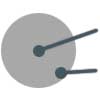100-70-03 Ductile Iron
Dura-Bar 100-70-03 ductile iron contains nodular graphite in a matrix of pearlite with small amounts of ferrite. The pearlitic structure maximizes strength and wear characteristics in a non-alloyed as-cast ductile iron. This specification conforms to ASTM A536 100-70-03. Download the 100-70-03 Product Brief to learn more.

Microstructure
The microstructure consists of Type I & Type II nodular graphite as defined in ASTM A247. The matrix is highly pearlite with small amounts of ferrite. The edge or rim will have a higher nodule count and contain slightly higher ferrite concentration when compared to the center. Chill carbides will be less than 5% in any field at 100x and will be well dispersed.
Center Area
100x, etched in 5% Nital

Edge Area
100x, etched in 5% Nital

Heat Treat Response
Dura-Bar 100-70-03 can be oil quench hardened from 1600° F (885° C) to a minimum hardness of Rockwell C 50 on the outside of the bar. The inside diameter hardness will be less than Rockwell C 50. Lower quench hardness on the inside diameters are a result of larger graphite nodules and not a loss of matrix hardness. Get more details including typical Jominy end quench curve, methods and cycle times, and temperature effects by downloading the Dura-Bar Heat Treating Guide.
Sizes
Dura-Bar Ductile 100-70-03 is a non-stock grade, which can be ordered in volume quantities from our distributors.
Technical Specifications
Chemical Composition
Carbon and silicon targets are specified for each bar size in order to maintain mechanical properties. Small amounts of alloying elements are used to stabilize the pearlitic structure. Magnesium treatment is employed to produce nodular graphite.
| Element | Percentage |
|---|---|
| Carbon | 3.50–3.90% |
| Silicon | 2.25–3.00% |
| Manganese | 0.15–0.35% |
| Sulfur | 0.025% Max |
| Phosphorus | 0.05% Max |
Mechanical Properties
Hardness properties for various diameters are shown in the table. Hardness properties listed are minimum and maximum across the bar. For rectangles, squares and shapes, the hardness properties will depend on minimum and maximum section thickness and will be supplied on request.
| Size Range | BHN | ||
|---|---|---|---|
| Inches | mm | Min | Max |
| 1.000–20.000 | 25–508 | 255 | 302 |
Tensile strength is determined from a longitudinal test specimen taken from mid-radius of the as-cast bar.
| Mechanical Properties | |
|---|---|
| Tensile strength psi (min) | 100,000 |
| Yield strength psi (min) | 70,000 |
| Elongation (min) | 3% |
Typical Applications
Automotive:
Gears
Fluid Power:
Cylinder blocks, Gerotors, Glands, Manifolds, Pistons, Rotors, Valves
Machinery:
Barrell Rollers, Bushings, Chain Sheave Rollers, Chuck Bodies, Die Blocks, Flywheels, Gear Racks, Gears, Housings, Pile Drivers, Pulleys, Rams, Rotary Tables
Miscellaneous:
Port Plate
Power Transmission:
Gears, Pulleys
Pump and Compressor:
Gears, Housings, Liners, Pistons, Rotors
Steel Mill:
Guide Rolls, Pinch Rolls, Runout Table Rolls
Transportation:
Camshafts, Carriers, Gears, Pulleys, Rail Spacers
